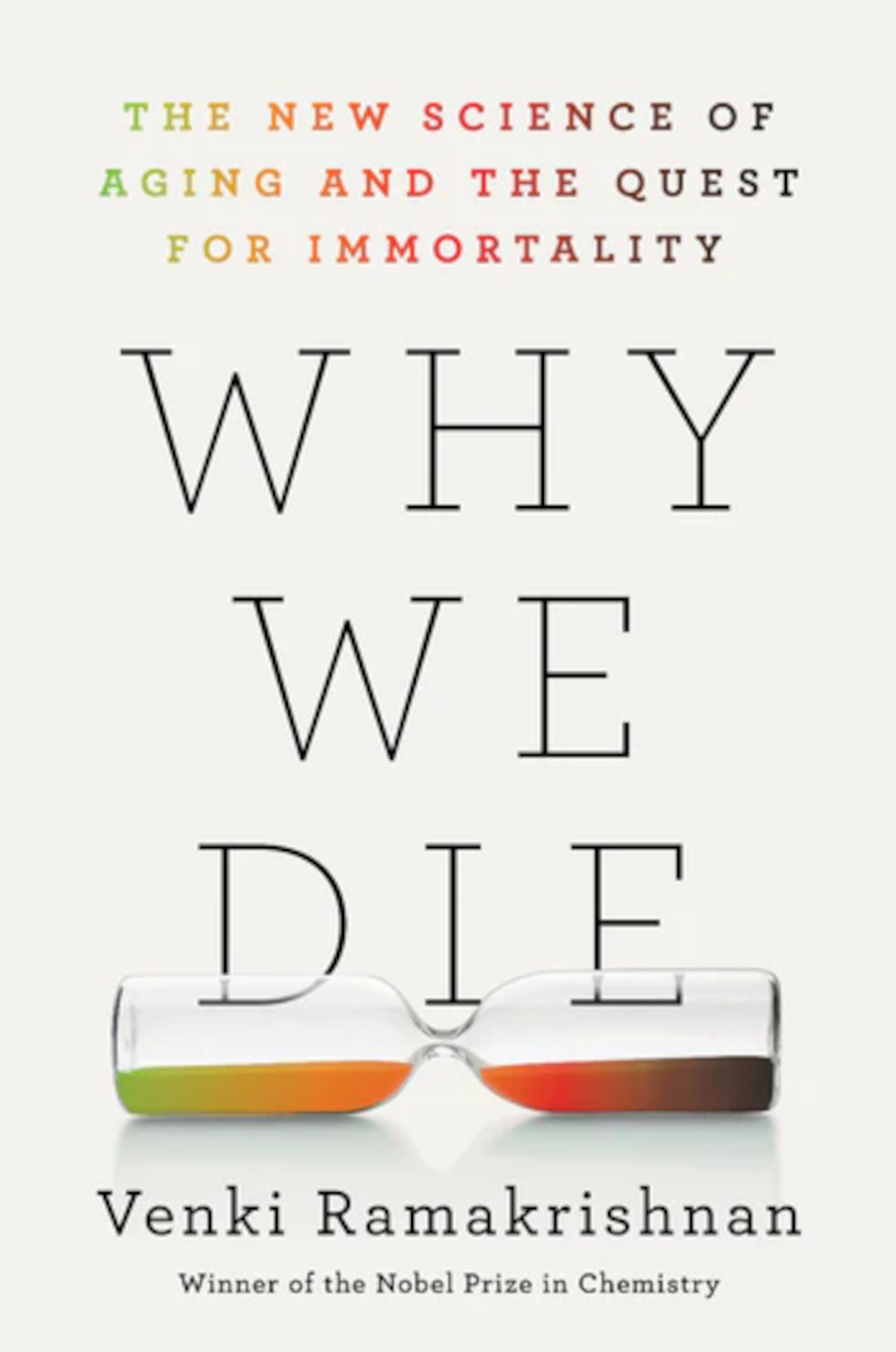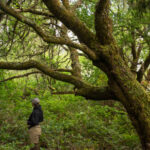In 2023, tech mogul Bryan Johnson revealed that he had been receiving blood plasma exchanges from his 17-year-old son, in the hope that siphoning his son’s young blood into his middle-aged body would help him combat aging and cheat death.

BOOK REVIEW — “Why We Die: The New Science of Aging and the Quest for Immortality,” by Venki Ramakrishnan (William Morrow, 320 pages).
Johnson might be an extreme outlier, but his quest exemplifies a common human trait: denial about our mortality. As Venki Ramakrishnan writes in his new book, “Why We Die: The New Science of Aging and the Quest for Immortality,” searching for the secrets to longevity has “driven human civilization for centuries.” Humans may be unique among animals in our ability to understand and anticipate death, and ever since we evolved into this awareness, we’ve struggled to accept it. We espouse religious beliefs about reincarnation or the everlasting immortal soul, we attempt to live on through offspring and legacy, and, of course, since antiquity, we have searched for eternal life.
Ramakrishnan, a Nobel Prize winner in chemistry who has spent his career studying how cell proteins are made, is primarily occupied with that last coping strategy in his fascinating book. For much of the 20th century, serious scientists dismissed gerontology, or the study of aging, as the provenance of cranks and loons. But in this century, it’s become a major research priority. In the past 10 years alone, Ramakrishnan writes, more than 700 startups have invested billions of dollars into solving this greatest human problem.
With a topic as charged as eternal life, it’s hard to separate hype from reality. Ramakrishnan aims to help readers make sense of billionaire antics, breathless press releases, and splashy scientific advances. He wants his reader to understand why we age, why we die, and what, realistically, can be done about it.
First, says Ramakrishnan, it’s important to understand what death is — he defines it as when “we stop functioning as a coherent whole” — and why we age. Scientists have spent decades pondering why, unlike luckier species like the hydra and immortal jellyfish, our bodies must decay. Many proposed answers to this question rest on the idea that evolution doesn’t care about traits that decay the body later in life: Since for much of human history, we died of disease or unnatural causes long before reaching old age, it made evolutionary sense to select for traits that help an organism reproduce and pass on its genes, rather than selecting for traits that will keep us alive for centuries. As Ramakrishnan colorfully and memorably writes, “You could say that death is the price we pay for sex!”
With a topic as charged as eternal life, it’s hard to separate hype from reality.
Death, of course, is preceded by aging — the wear and tear of time that slowly but surely destroys our bodies. We now have an increasingly sophisticated overview of how this process works. It all starts with our DNA. As a person ages, her DNA deteriorates and loses its self-repairing abilities. Other systems break down, too. Proteins run amok, sparking diseases like dementia and Alzheimer’s. Telomeres, long stretches of DNA that form a protective cap on chromosomes, become shorter as cells divide and eventually cannot adequately protect the underlying DNA, leading to cell death. And mitochondria, the cellular structures that produce energy, accumulate defects, leaving the aging person weaker and sicker. “You can see why my grandson, with his young, healthy mitochondria, might feel so much more energetic — and generally healthier — than I do,” laments Ramakrishnan.
Have scientists developed any tools to reverse this decay? Sort of. As he explains the mechanisms of aging, Ramakrishnan also details the attempts to “compress morbidity,” or to reduce the amount of time that people spend suffering at the end of their lives. Of special interest to gerontologists are those protective telomeres. Biotech companies are experimenting with reintroducing the enzyme that promotes telomere growth, in order to reverse aging. Another approach involves using stem cells to replace dead or damaged tissue. But tinkering with the body often leads to unforeseen consequences: both telomere lengthening and tissue rejuvenation are associated with eternal life’s other big enemy, cancer.
In Ramakrishnan’s view, one of the most promising therapies was discovered by investigating caloric restriction. Unfortunately, science has borne out the idea that eating a bare minimum (enough to avoid malnutrition) combats aging: specifically, cutting down on calories inhibits cellular processes that lead to aging. The good news is that researchers are finding ways to inhibit that process without requiring self-starvation. Rapamycin, a drug derived from an Easter Island soil sample, can mimic the benefits of a low-calorie diet.
At the other end of the plausibility spectrum lies cryogenics, or freezing one’s body or head immediately after death in the hopes of eventual rejuvenation, a pricey practice that Ramakrishnan describes in an entertaining chapter called “Crackpots or Prophets?” (The verdict on cryogenics enthusiasts: crackpots.)
Ramakrishnan’s narrative occasionally wanders too far into the minutiae of our cells, our DNA, and our proteins. Luckily, though, his writing is clever and approachable. He strives to demystify these high-context ideas for the average reader, and his chapters often begin with lively anecdotes that act as metaphors or exemplars for his scientific concepts, like a charming personal anecdote about how Ramakrishnan panics whenever an appointment slips his mind or he misplaces his umbrella, worrying that his 70-year-old neurons are losing control of their protein production and slipping into dementia. We also meet fascinating scientists in the old-fashioned gentleman-explorer mold, like Aubrey de Grey, an “English eccentric” with a “large cultlike following” who believes that the first humans to live to 1,000 have already been born.
But beware: Readers who’ve picked up “Why We Die” for wild promises like de Grey’s will be disappointed. Although Ramakrishnan charts incredible advances in our understanding of the aging process, he also points out just how little progress we’ve made in halting aging. “How has such an enormous industry flourished for so long with so few actual advances to show for it?” he asks.
The stark truth is that we start aging while we are still in utero: We really are born to die.
Indeed, although public health advances have decreased childhood mortality and greatly improved life expectancy over the past century and a half, scientists have done nothing to raise the maximum human life span, which has remained constant at about 120. Ramakrishnan is not even convinced that we should live longer: He worries that biotechnology companies working on the aging problem are not considering the social consequences of creating an even larger geriatric population, which could include new expectations that the elderly work into their 80s and 90s; dramatic overpopulation; a glut of older people refusing to relinquish control of our political systems; and a bifurcated humanity where those at the top are gifted long lives while those at the bottom receive the opposite. It doesn’t take a rich imagination to picture that bifurcated world: In many ways, it already exists. In the United States, the rich live about 10 to 15 years longer than the poor. Anti-aging efforts will likely only exacerbate inequality, Ramakrishnan writes.
Ramakrishnan is not even convinced that we would be existentially satisfied with longer life spans. The stark truth is that we start aging while we are still in utero: We really are born to die. And so far, according to Ramakrishnan, the best anti-death treatments are age-old and certainly not flashy: eat well, exercise, sleep, and while you have it, enjoy life. Because despite Silicon Valley’s best efforts, it’s still fleeting.
Emily Cataneo is a writer and journalist from New England whose work has appeared in Slate, NPR, the Baffler, and Atlas Obscura, among other publications.











